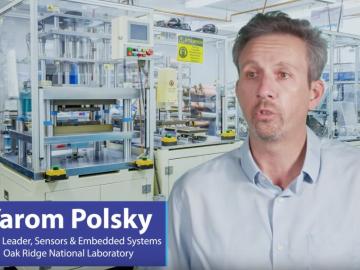
Filter News
Area of Research
- Advanced Manufacturing (1)
- Biology and Environment (27)
- Computational Engineering (1)
- Computer Science (1)
- Energy Science (24)
- Fusion and Fission (3)
- Isotopes (4)
- Materials (46)
- Materials for Computing (5)
- National Security (15)
- Neutron Science (16)
- Nuclear Science and Technology (3)
- Quantum information Science (1)
- Supercomputing (25)
News Type
News Topics
- (-) Biomedical (30)
- (-) Chemical Sciences (44)
- (-) Clean Water (9)
- (-) Composites (15)
- (-) Cybersecurity (23)
- (-) Physics (42)
- (-) Summit (24)
- 3-D Printing/Advanced Manufacturing (61)
- Advanced Reactors (14)
- Artificial Intelligence (44)
- Big Data (20)
- Bioenergy (48)
- Biology (53)
- Biotechnology (17)
- Buildings (25)
- Computer Science (77)
- Coronavirus (23)
- Critical Materials (13)
- Education (3)
- Element Discovery (1)
- Energy Storage (56)
- Environment (78)
- Exascale Computing (16)
- Fossil Energy (1)
- Frontier (19)
- Fusion (26)
- Grid (23)
- High-Performance Computing (43)
- Hydropower (2)
- Isotopes (33)
- ITER (3)
- Machine Learning (23)
- Materials (69)
- Materials Science (71)
- Mathematics (5)
- Mercury (6)
- Microelectronics (1)
- Microscopy (28)
- Molten Salt (3)
- Nanotechnology (35)
- National Security (35)
- Neutron Science (64)
- Nuclear Energy (44)
- Partnerships (33)
- Polymers (18)
- Quantum Computing (14)
- Quantum Science (36)
- Security (19)
- Simulation (18)
- Space Exploration (3)
- Statistics (1)
- Transportation (38)
Media Contacts

The National Alliance for Water Innovation, a partnership of the Department of Energy’s Oak Ridge National Laboratory, other national labs, university and private sector partners, has been awarded a five-year, $100 million Energy-Water Desalination Hub by DOE to address water security issues in the United States.

Three researchers at Oak Ridge National Laboratory will lead or participate in collaborative research projects aimed at harnessing the power of quantum mechanics to advance a range of technologies including computing, fiber optics and network

An ORNL-led team's observation of certain crystalline ice phases challenges accepted theories about super-cooled water and non-crystalline ice. Their findings, reported in the journal Nature, will also lead to better understanding of ice and its various phases found on other planets, moons and elsewhere in space.

OAK RIDGE, Tenn., March 20, 2019—Direct observations of the structure and catalytic mechanism of a prototypical kinase enzyme—protein kinase A or PKA—will provide researchers and drug developers with significantly enhanced abilities to understand and treat fatal diseases and neurological disorders such as cancer, diabetes, and cystic fibrosis.

OAK RIDGE, Tenn., March 11, 2019—An international collaboration including scientists at the Department of Energy’s Oak Ridge National Laboratory solved a 50-year-old puzzle that explains why beta decays of atomic nuclei

OAK RIDGE, Tenn., March 4, 2019—A team of researchers from the Department of Energy’s Oak Ridge National Laboratory Health Data Sciences Institute have harnessed the power of artificial intelligence to better match cancer patients with clinical trials.

More than 1800 years ago, Chinese astronomers puzzled over the sudden appearance of a bright “guest star” in the sky, unaware that they were witnessing the cosmic forge of a supernova, an event repeated countless times scattered across the universe.
OAK RIDGE, Tenn., Feb. 12, 2019—A team of researchers from the Department of Energy’s Oak Ridge and Los Alamos National Laboratories has partnered with EPB, a Chattanooga utility and telecommunications company, to demonstrate the effectiveness of metro-scale quantum key distribution (QKD).

A team of scientists has for the first time measured the elusive weak interaction between protons and neutrons in the nucleus of an atom. They had chosen the simplest nucleus consisting of one neutron and one proton for the study.

Scientists at the Department of Energy’s Oak Ridge National Laboratory have created a recipe for a renewable 3D printing feedstock that could spur a profitable new use for an intractable biorefinery byproduct: lignin.


